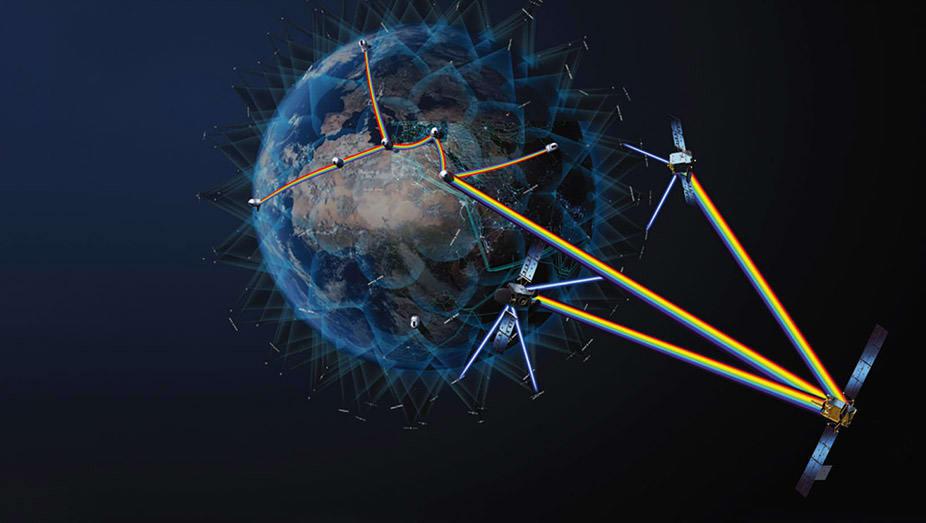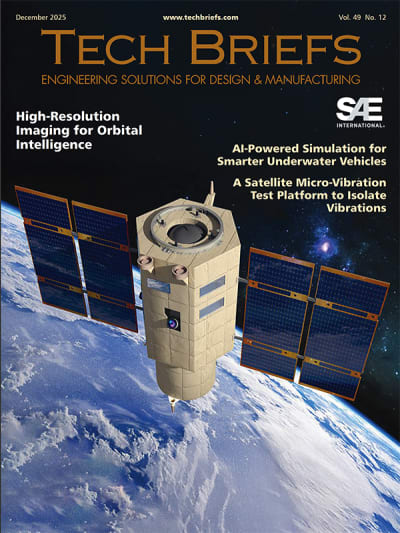
Optical space communication that uses lasers instead of radio waves to transmit data between spacecraft or from space to Earth offers enormous potential but also faces several technical challenges. Because optical systems can transmit far more date per second than traditional radio systems, they are critical for missions to the Moon, Mars, and beyond, so overcoming these challenges can unlock a new era of space-based connectivity.
In February 2025, Thales Alenia Space, signed a contract with the European Space Agency (ESA) for Element #2 of the HydRON (High-thRoughput Optical space Network) Demonstration System (DS) for the design, development, deployment and in-orbit demonstration of a full end-to-end optical system to verify and validate the world’s first all-optical, high-data-rate, multi-orbit transport network in space.
HydRON aims to transform the way data-collecting satellites communicate, using laser technology that will allow satellites to connect with each other and ground networks much faster. By enabling rapid, high-capacity connections between satellites and ground networks, HydRON has the potential to significantly enhance the ability to collect and utilize data from space.
In this in-depth interview, Antonio Sturiale, Director of Telecom Domain in Italy at Thales Alenia Space, discusses HydRON and the company’s approach to optical communications as well as the role it will play in upcoming lunar, Martian, and deep-space exploration missions.
Tech Briefs: What are the current limitations of space optical communications, and how close are we to overcoming challenges like atmospheric interference and beam alignment for deep-space applications?
Antonio Sturiale: The two key characteristics of optical communications allowing to provide very high data rates, minimizing at the same time the interferences, are the very narrow optical beams and the ultra-wide bands. To leverage these two elements, the architecture of optical communication in space has to ensure a very high pointing/tracking accuracy, in order to establish and maintain point-to-point links with high reliability and different photonic and digital technologies able to perform optical/electrical transduction as well as digital signal processing at high data rate.
Narrow optical beams are highly affected by atmospheric turbulence, especially in uplink where the optical beam is deflected by the turbulence cell close to the transmitter and potentially causing the beam to completely miss the target. Techniques as Adaptive Optics and Forward Error Correction are known to mitigate this effect by minimizing the impact on the end-to-end communication. These techniques have already been proven in laboratory and on some experimental ground-LEO/GEO mission. Their capability to support a reliable operative service is to be finally validated through HydRON and other similar initiatives in Europe, U.S., Japan, and China.
For deep-space applications these aspects are even more critical since the very large distance increases the beam travel time and reduces the received power. High-performance acquisition and tracking techniques as well as highly sensitive receivers, based on photon counting, are being studied within different ESA projects. On the U.S. side, in 2023 NASA proved the ability of transmitting data on an optical link from the deep-space mission Psyche, 19 million km afar.
A system like HydRON can represent a gateway to Earth for deep-space missions by providing a network of in-space access points to the different missions, with maximum visibility time and resilience to the local weather conditions.
Tech Briefs: What is the HydRON (High-thRoughput Optical space Network) Demonstration System?
Sturiale: HydRON is a project within the ESA ARTES Strategic Programme Line on Optical and Quantum Communication (ScyLight) and was first presented at the Ministerial Council in November 2019.

HydRON aims to demonstrate the world’s first (all) optical multi-orbit transport network at terabit/sec capacity in space, extending terrestrial Fiber-based networks seamlessly into space — in other words, HydRON will demonstrate the “Fiber in the Sky” and the “Internet beyond Cloud(s).” HydRON Demonstration System (HydRON-DS) is an optimized solution that deploys the key technologies required for the realization of the future High Throughput Network-in-the-Sky. The architecture is designed in order to support the full HydRON vision and allowing for scalability and expandability.
The HydRON-DS system is composed of three elements:
Element #1: A high-throughput optical LEO Ring Layer
Element #2: A high-throughput optical LEO Multi-Orbit Extension Layer
Element #3: A demonstration/service user segment
Tech Briefs: How will HydRON significantly enhance the ability to collect and utilize data from space?
Sturiale: The HydRON-DS will deploy an E2E network-in-the-sky based on both in-space and on-ground core/access nodes able to route traffic from/to any user in-space or on-ground. The system is based on a 10G packet switched and 100G circuit switched network based on Multi-Protocol Label Switching (MPLS) technology with advanced routing models. The architecture is designed to support the demonstration of 100G optical links (both OISL and OGSL).

Furthermore, the HydRON-DS will demonstrate interoperability with satellite operators providing a high-data rate transport service.
Tech Briefs: What specific challenges does Thales Alenia Space anticipate in implementing laser-based communication technologies?
Sturiale: Thales Alenia Space is the prime contractor of HydRON-DS, leading a consortium of Italian and European partners. Thales Alenia Space in Italy is responsible for the E2E system and the space segment with specific focus on the development of key high data rate digital technologies both in space and on ground.
The HydRON-DS Element #2 is composed of one HydRON-DS LEO Collector satellite, a GEO hosted payload, and two Optical Ground Stations (OGS), one of these transportable. The network is orchestrated by an HydRON Control Centre (HCC) equipped with HydRON Network Control Center (HNCC). A HydRON Satellite Control Center (HSCC) provides monitoring and control of the LEO satellite.
One of the challenges lies in the development of a technology able to exchange data at 100Gbps between two satellites and between a satellite and a ground station. The two critical aspects related to this objective are: the challenge of developing highly reactive beam correction techniques (adaptive optics) and the computational power required to process very high data rate signals onboard satellites, modulating/demodulating it, and encoding/decoding it. Another technical challenge is to perform high data rate packet switching onboard the satellite, which require adapting to protocol standards developed for ground networks to the dynamicity and complexity of a space network.
Tech Briefs: Considering NASA’s recent success with the Deep Space Optical Communications (DSOC) experiment aboard the Psyche spacecraft, how does Thales Alenia Space’s approach to optical communications compare or differ?
Sturiale: The Psyche exploration mission developed by NASA, using a point-to-point optical communication link, leverages on a multi beam transmit system and single photon detectors technologies to allow cross-atmospheric communication at the required distance. This is one off. The Thales Alenia Space solution starts from the same promising approach to the DSOC, multi-beam transmitter and photon detectors, and it introduces some new technologies, specifically developed in the frame of HydRON and other ESA initiatives, to materialize a more robust and resilient solution.
One of the key new elements is the Delay-Tolerant-Networks (DTN) technique, developed to provide communication services to satellites or spacecraft across the solar system. The result is achieved by implementing an interplanetary network, with a dedicated and standardized interface, that allows systems to use multiple hops to transfer the information from the source to the destination, crossing multiple networks.
Tech Briefs: In what ways can the adoption of optical communication technologies improve the efficiency and reliability of lunar exploration data exchanges?
Sturiale: The interest in lunar exploration has greatly increased in the last years, moving from single objectives such as performing dedicated exploration missions to inhabiting the Earth satellite. This view requires the deployment of complete systems around the Moon, providing communication, navigation, and observation services. These systems require a constant connection with Earth ground network at high data rate to allow the exchange of large sets of information.
An optical communications network will create a “data distribution infrastructure” supporting very high data rate traffic over long distances, achieving data rates in the order of tens of Gbps to and from the Moon. Furthermore, since the Moon has no atmosphere, the optical links can reliably interconnect lunar users without the need for complex turbulence mitigation techniques for local links.
Finally, the low interference characteristics of optical beams allows to minimize the need for frequency coordination among the different missions.
Tech Briefs: Looking ahead, how do you foresee optical communications evolving over the next decade, and what role will they play in upcoming lunar and deep-space exploration missions?
Sturiale: As far as, in the next few years the whole technologies complete the pre-operative and operative validation process, optical communications will play a key role in inter-planetary exploration supporting long-range links at high data rate and enabling a sustainable deployment of interconnected interplanetary networks providing a transport layer for communication, observation, and Position-Navigation-Timing (PNT) services to assets on the Moon, Mars, and across the solar system.
Moreover, approximately starting by the end of this decade, some implications of these technologies will create a positive economy environment on the Earth, through “secure connectivity” services. This opportunity will be emphasized by some of the peculiarities of optical communication such as the “point-to-point link” compared to the “signal distribution” of radiofrequency-based services, and by supporting quantum native applications.
This article was written by Chitra Sethi, Editorial Director, SAE Media Group. For more information, visit here .
Which breakthroughs will redefine the future of space communications? Join us for a free webinar on October 15, 2025, to learn more. Register here: techbriefs.com/space-comm-webinar.

